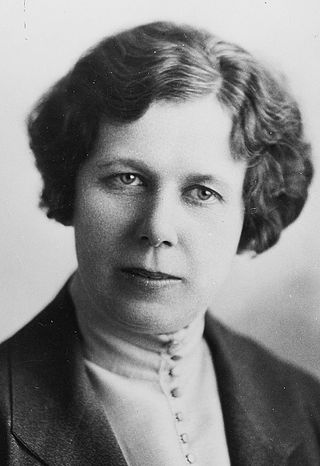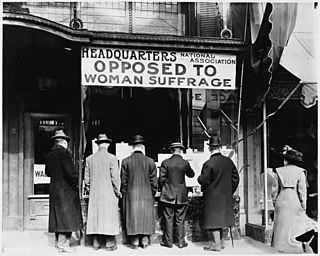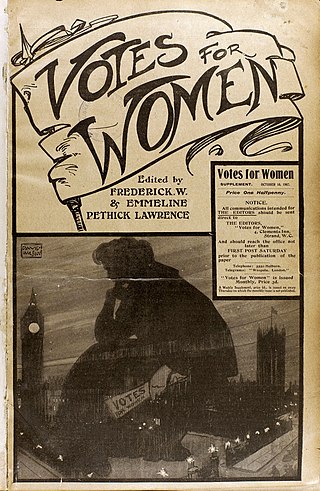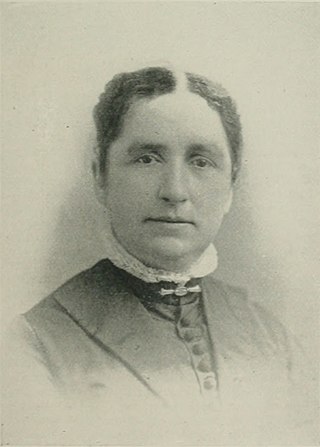
The Women's Social and Political Union (WSPU) was a women-only political movement and leading militant organisation campaigning for women's suffrage in the United Kingdom from 1903 to 1918. Known from 1906 as the suffragettes, its membership and policies were tightly controlled by Emmeline Pankhurst and her daughters Christabel and Sylvia; Sylvia was eventually expelled.

Gladys Shields Pyle was an American educator, politician and the first woman elected to the United States Senate without having previously been appointed to her position; she was also the first female senator to serve as a Republican and the first female senator from South Dakota. Further, she was the first female senator from outside the south. She was also the first unmarried female senator.

Women's legal right to vote was established in the United States over the course of more than half a century, first in various states and localities, sometimes on a limited basis, and then nationally in 1920 with the passing of the 19th Amendment.

Harlan John Bushfield was an American politician from South Dakota. He served as the 16th governor of South Dakota and as a United States senator.

Anti-suffragism was a political movement composed of both men and women that began in the late 19th century in order to campaign against women's suffrage in countries such as Australia, Canada, Ireland, the United Kingdom and the United States. To some extent, Anti-suffragism was a Classical Conservative movement that sought to keep the status quo for women. More American women organized against their own right to vote than in favor of it, until 1916. Anti-suffragism was associated with "domestic feminism," the belief that women had the right to complete freedom within the home. In the United States, these activists were often referred to as "remonstrants" or "antis."

A movement to fight for women's right to vote in the United Kingdom finally succeeded through acts of Parliament in 1918 and 1928. It became a national movement in the Victorian era. Women were not explicitly banned from voting in Great Britain until the Reform Act 1832 and the Municipal Corporations Act 1835. In 1872 the fight for women's suffrage became a national movement with the formation of the National Society for Women's Suffrage and later the more influential National Union of Women's Suffrage Societies (NUWSS). As well as in England, women's suffrage movements in Wales, Scotland and other parts of the United Kingdom gained momentum. The movements shifted sentiments in favour of woman suffrage by 1906. It was at this point that the militant campaign began with the formation of the Women's Social and Political Union (WSPU).

The history of South Dakota describes the history of the U.S. state of South Dakota over the course of several millennia, from its first inhabitants to the recent issues facing the state.

The Karcher–Sahr House is a historic house located at 222 E. Prospect St. in Pierre, South Dakota. Built in 1910, the house was designed in the Classical Revival style. The house's design features a dentillated cornice with modillions and moldings, two-story Ionic columns supporting a pediment over the front entrance, and a front and side porch. The house's first owner, Henry Karcher, was an early settler and businessman in Pierre who also served as the city's mayor. After his daughter Marguerite married Fred Sahr, the couple lived in the house. Marguerite was a prominent activist for women's suffrage, and her son William was a state legislator.

The following works deal with the cultural, political, economic, military, biographical and geologic history of pre-territorial South Dakota, the southern part of Dakota Territory and the State of South Dakota.

Women's suffrage was established in the United States on a full or partial basis by various towns, counties, states and territories during the latter decades of the 19th century and early part of the 20th century. As women received the right to vote in some places, they began running for public office and gaining positions as school board members, county clerks, state legislators, judges, and, in the case of Jeannette Rankin, as a member of Congress.

The National Association Opposed to Women Suffrage (NAOWS) was founded in the United States by women opposed to the suffrage movement in 1911. It was the most popular anti-suffrage organization in northeastern cities. NAOWS had influential local chapters in many states, including Texas and Virginia.

Votes for Women was a newspaper associated with the women's suffrage movement in the United Kingdom. Until 1912, it was the official newspaper of the Women's Social and Political Union, the leading suffragette organisation. Subsequently, it continued with a smaller circulation, at first independently, and then as the publication of the United Suffragists.

Mary "Mamie" Shields Pyle was a women's suffrage leader in the U.S. state of South Dakota. She was instrumental in the state's enactment of women's suffrage in 1918.

Marietta Bones was an American woman suffragist, social reformer, and philanthropist. In 1881 Bones was elected vice-president of the National Woman Suffrage Association (NWSA) and annually re-elected for nine years. In 1890 suffragist Susan B. Anthony and supporters of the movement merged the National Women Suffrage Association into the National American Women Suffrage Association (NAWSA). In 1882, Bones made her first appearance as a public speaker in Webster, soon to be Webster, South Dakota, where she later resided. She was an active temperance worker, and was secretary of the first Non-Partisan National Woman's Christian Temperance Union in 1889. She took great interest in all reform and charitable institutions.
Ruth B. Hipple (1873-1962) was an American suffragist.

Women's suffrage in South Dakota started when it was part of Dakota Territory. Prior to 1889, it had a shared women's suffrage history with North Dakota. While South Dakota was part of the territory, women earned the right to vote on school related issues. They retained this right after it became a separate state. The state constitution specified that there would be a women's suffrage amendment referendum in 1890. Despite a large campaign that included Susan B. Anthony and a state suffrage group, the South Dakota Equal Suffrage Association (SDESA), the referendum failed. The state legislature passed additional suffrage referendums over the years, but each was voted down until 1918. South Dakota was an early ratifier of the Nineteenth Amendment, which was approved during a special midnight legislative session on December 4, 1919.

Janette Hill Knox was an American temperance reformer, suffragist, teacher, author and editor.

This is a timeline of women's suffrage in South Dakota. The early history of women's suffrage in the state is shared with North Dakota. When South Dakota became a state, it held a voter referendum in 1890 on an equal suffrage amendment. This effort failed, but suffragists continued to organize and lobby the legislature to pass voter referendums. None passed until 1918. South Dakota ratified the Nineteenth Amendment on December 4, 1919.

















